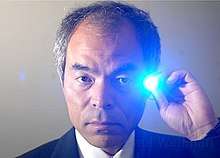Shuji Nakamura
Shuji Nakamura (中村 修二, Nakamura Shūji, born May 22, 1954) FREng is a Japanese-born American electronic engineer and prolific inventor specializing in the field of semiconductor technology, professor at the Materials Department of the College of Engineering, University of California, Santa Barbara (UCSB),[5] and is regarded as the inventor of the blue LED, a major breakthrough in lighting technology.[6] Together with Isamu Akasaki and Hiroshi Amano, he is one of the three recipients of the 2014 Nobel Prize for Physics "for the invention of efficient blue light-emitting diodes, which has enabled bright and energy-saving white light sources". In 2015, his input into commercialization and development of energy-efficient white LED lighting technology was recognized by the Global Energy Prize.
Shuji Nakamura | |
|---|---|
 Shuji Nakamura in 2015 | |
| Born | 22 May 1954 Ikata, Ehime, Japan |
| Nationality | American[1][2] |
| Citizenship | Japan (until 2005) United States (since 2005)[3][4] |
| Alma mater | University of Tokushima |
| Known for | Blue and white LEDs |
| Awards | Millennium Technology Prize (2006) Harvey Prize (2009) Nobel Prize in Physics (2014) Global Energy Prize (2015) National Inventors Hall of Fame (2015) Mountbatten Medal (2017) Zayed Future Energy Prize (2018) |
| Scientific career | |
| Fields | Electronics engineering |
| Institutions | University of California, Santa Barbara |
Career
Nakamura graduated from the University of Tokushima in 1977 with a B.Eng. degree in electronic engineering, and obtained an M.Eng. degree in the same subject two years later, after which he joined the Nichia Corporation, also based in Tokushima. It was while working for Nichia that Nakamura invented the first high brightness gallium nitride (GaN) LED whose brilliant blue light, when partially converted to yellow by a phosphor coating, is the key to white LED lighting, which went into production in 1993.
Previously, J. I. Pankove and co-workers at RCA put in considerable effort, but did not manage to make a marketable GaN LED in the 1960s. The principal problem was the difficulty of making strongly p-type GaN. Nakamura drew on the work of another Japanese group led by Professor Isamu Akasaki, who published their method to make strongly p-type GaN by electron-beam irradiation of magnesium-doped GaN. However, this method was not suitable for mass production and its physics were not well understood. Nakamura managed to develop a thermal annealing method which was much more suitable for mass production. In addition, he and his co-workers worked out the physics and pointed out the culprit was hydrogen, which passivated acceptors in GaN.
At the time, many considered creating a GaN LED too difficult to produce; therefore Nakamura was fortunate that the founder of Nichia, Nobuo Ogawa (1912–2002), was initially willing to support his GaN project. However the company eventually ordered him to suspend work on GaN, claiming it was consuming too much time and money. Nakamura continued to develop the blue LED on his own and in 1993 succeeded in making the device.[7]
He was awarded a D.Eng. degree from the University of Tokushima in 1994. He left Nichia Corporation in 1999 and took a position as a professor of engineering at the University of California, Santa Barbara.
In 2001, Nakamura sued his former employer Nichia over his bonus for the discovery as a part of a series of lawsuits between Nichia and Nakamura with Nichia's US competitor Cree Inc.; they agreed in 2000 to jointly sue Nichia at the expense of Cree and Nakamura received stock options from Cree. Nakamura claimed that he received only ¥20,000 (≈US$180) for his discovery of "404 patent," though Nichia revealed that the company awarded him with promotions and bonuses of 62 million yen over 11 years and his annual salary reached 20 million yen when he quit Nichia.[8]
Although Nakamura originally won an appeal for ¥20 billion (≈US$180 million), Nichia appealed the award and the parties settled in 2005 for ¥840 million (≈US$9 million), at the time the largest bonus ever paid by a Japanese company.;[9] this was, however, consumed by legal fees incurred by Nakamura in reaching the settlement [10]
Nakamura has also worked on green LEDs, and is responsible for creating the white LED and blue laser diodes used in Blu-ray Discs and HD DVDs.[11]
Nakamura is a professor of Materials at the University of California, Santa Barbara.[12] In 2008, Nakamura, along with fellow UCSB professors Dr. Steven DenBaars and Dr. James Speck, founded Soraa, a developer of solid-state lighting technology built on pure gallium nitride substrates.[13] Nakamura holds 208 US utility patents as of May 5, 2020.[14]
Recognition
- 2001 – Asahi Prize from the Japanese Newspaper, Asahi Shimbun
- 2002 – Benjamin Franklin Medal in Physics from the Franklin Institute.
- 2006 – Finland's Millennium Technology Prize for his continuing efforts to make cheaper and more efficient light sources.[15][16]
- 2007 – nominee for the European Inventor Award awarded by the European Patent Office [17]
- 2008 – Prince of Asturias Award for Technical and Scientific Research.[18]
- 2008 – Honorary degree of Doctor of Engineering from Hong Kong University of Science and Technology.
- 2008 - Holst Memorial Lecture Award [Eindhoven University of Technology and Royal Philips Research, the Netherlands].
- 2009 – Harvey Prize[19] from the Technion in Israel.
- 2012 – Silicon Valley Intellectual Property Law Association (SVIPLA) Inventor of the Year.[20]
- 2014 – Nobel Prize in Physics together with Prof. Isamu Akasaki and Prof. Hiroshi Amano for inventing blue light-emitting diodes.[21]
- 2015 – Global Energy Prize for the invention, commercialization and development of energy-efficient white LED lighting technology [22]
- 2017 – Mountbatten Medal[23]
- 2018 – Zayed Future Energy Prize[24]
See also
References
- "中村教授「物理学賞での受賞には驚いた」 ノーベル賞". The Nikkei. Nikkei Inc. October 2014.
- Shuji received American citizenship in 2000. Japan does not recognize dual nationality.
- 特許は会社のもの「猛反対」 ノーベル賞の中村修二さん [Patent belongs to the company "Violent opposition" Nobel prize winner Shuji Nakamura] (in Japanese). Asahi Shimbun Digital. 18 October 2014.
- ノーベル賞の中村修二氏、「アメリカの市民権」を取った理由を語る [Nobel prize winner Shuji Nakamura talks about why he acquired U.S. citizenship] (in Japanese). withnews. 18 October 2014.
2005、6年ごろに(米国市民権を)取ったんですよ [acquired (U.S. citizenship) in 2005 or 2006]
- "Shuji Nakamura". Santa Barbara: University of California. Archived from the original on July 15, 2010. Retrieved July 31, 2008.
- "Nobel laureate fought the odds to make history". Pacific Coast Business Times. Retrieved Oct 10, 2014.
- "Court dismisses inventor's patent claim but will consider reward". The Japan Times. September 20, 2002. Archived from the original on October 8, 2014. Retrieved October 7, 2014.
- 日亜化学工業社長の小川英治氏 訴訟騒動の真実を今こそ明らかにする [Nichia president Eiji Ogama now revealed the truth behind the court] (in Japanese). Nikkei Tech-on. April 2004. Archived from the original on 7 October 2014. Retrieved 1 December 2014.
- Zaun, Todd (January 12, 2005). "Japanese Company to Pay Ex-Employee $8.1 Million for Invention". The New York Times. Retrieved October 7, 2014.
- "The man who had the world's brightest idea, by Robert Matthews. Financial Times 4 April 2007".
- Richard Harris (June 15, 2006). "Work in Colored Lights Nets Millennium Prize". All Things Considered.
- "Shuji Nakamura". Solid State Lighting & Energy Center. Archived from the original on May 28, 2013. Retrieved October 19, 2012.
- "About". Soraa Inc. Retrieved October 19, 2012.
- Patents of Shuji Nakamura
- Shuji Nakamura wins the 2006 Millennium Technology Prize
- "Top prize for 'light' inventor". BBC News. September 8, 2006. Archived from the original on March 5, 2007. Retrieved 2006-09-08.
- Office, European Patent. "Shuji Nakamura (Japan)". www.epo.org.
- Prince of Asturias Awards for Technical and Scientific Research.
- "Harvey Prize". Archived from the original on July 27, 2011.
- "SVIPLA Presents Inventor of the Year - Shuji Nakamura, Ph.D." Silicon Valley Intellectual Property Law Association. Retrieved 5 March 2013.
- "The 2014 Nobel Prize in Physics - Press Release". Nobelprize.org. Nobel Media AB 2014. Retrieved October 7, 2014.
- "Laureates". globalenergyprize.org.
- "Mountbatten Medal – 2017 Winner". Institution of Engineering and Technology. Retrieved September 25, 2017.
- Sankar, Anjana. "Top Zayed Energy prize awarded to LED light inventor". www.khaleejtimes.com. Retrieved 2018-01-17.
Further reading
- Shuji Nakamura, Gerhard Fasol, Stephen J. Pearton, The Blue Laser Diode : The Complete Story, Springer; 2nd edition, October 2, 2000, (ISBN 3-540-66505-6)
- Bob Johnstone Brilliant!: Shuji Nakamura and the revolution in lighting technology, Prometheus Books, 2007 ISBN 1-59102-462-5
External links
- Professor Nakamura's home page at UCSB
- The Solid State Lighting and Energy Center at UCSB
- Shuji Nakamura Wins $188.7 Million Settlement from Former Employer Nichia for Blue Spectrum Breakthrough Technology
- New York Times article on Nakamura's settlement with Nichia
- U.S. Patent 6,900,465 — Nitride semiconductor light-emitting device
- Shuji Nakamura wins the 2006 Millennium Technology Prize
- Nichia's Shuji Nakamura: Dream of the Blue Laser Diode
- 2008 Prince of Asturias Award For Technical and Scientific Research
- Harvey Prize
- Shuji Nakamura SPIE Photonics West plenary presentation: Future and present technologies of solid state lighting
| Preceded by Tim Berners-Lee |
Millennium Technology Prize winner 2006 (for blue and white LEDs) |
Succeeded by Robert S. Langer |

